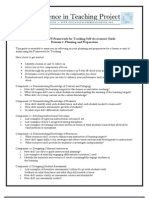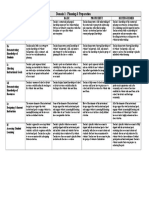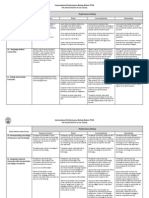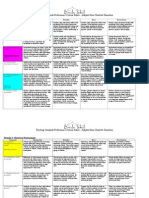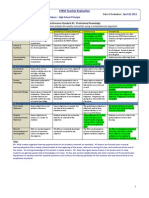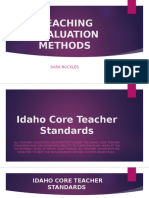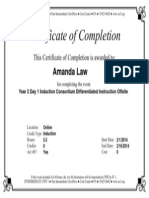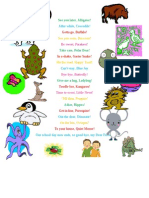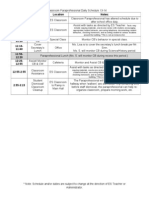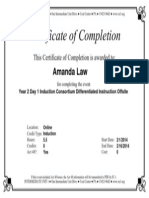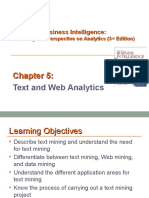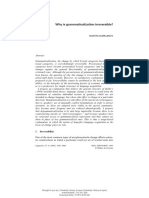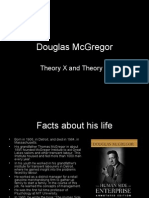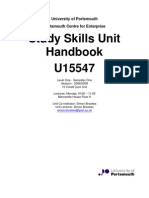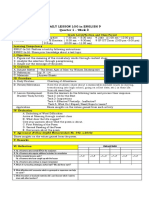0 ratings0% found this document useful (0 votes)
180 viewsTeacher Self Assessment 1
Teacher Self Assessment 1
Uploaded by
api-253664586Copyright:
© All Rights Reserved
Available Formats
Download as PDF, TXT or read online from Scribd
Teacher Self Assessment 1
Teacher Self Assessment 1
Uploaded by
api-2536645860 ratings0% found this document useful (0 votes)
180 views9 pagesOriginal Title
teacher self assessment 1
Copyright
© © All Rights Reserved
Available Formats
PDF, TXT or read online from Scribd
Share this document
Did you find this document useful?
Is this content inappropriate?
Copyright:
© All Rights Reserved
Available Formats
Download as PDF, TXT or read online from Scribd
Download as pdf or txt
0 ratings0% found this document useful (0 votes)
180 views9 pagesTeacher Self Assessment 1
Teacher Self Assessment 1
Uploaded by
api-253664586Copyright:
© All Rights Reserved
Available Formats
Download as PDF, TXT or read online from Scribd
Download as pdf or txt
You are on page 1of 9
Walk-through Name Template
Teacher Self Assessment PA - Teacher Self Assessment Form
Board Name School Name
Southeastern Greene School District Bobtown Elementary School
Observer Subject
Amanda Law Amanda Law
Start Date/Time End Date/Time
Wed May 07 2014 08:23 PM Wed May 07 2014 09:19 PM
Observer
TEACHERS INTRUCTIONS: In the Pre-Observation Stage please attach lesson plan and complete the questions associated
with Domains 1 and 4 (excluding component 4A). Use this form to rate yourself on the rubric for Domains 1 - 4 in the Post
Observation.
DOMAIN 1
1a. Demonstrating Knowledge of Content and Pedagogy:
What is the content to be taught?
What prerequisite learning is required?
PROFICIENT
FAILING
Teachers plans and practice
display little knowledge of the
content, prerequisite
relationships between diferent
aspects of the content, or of the
instructional practices specifc to
that discipline.
NEEDS IMPROVEMENT
Teachers plans and practice
refect some awareness of the
important concepts in the
discipline, prerequisite relations
between them and of the
instructional practices specifc to
that discipline.
PROFICIENT
Teachers plans and practice
refect solid knowledge of the
content, prerequisite relations
between important concepts and
of the instructional practices
specifc to that discipline.
DISTINGUISHED
Teachers plans and practice
refect extensive knowledge of
the content and of the structure
of the discipline. Teacher actively
builds on knowledge of
prerequisites and misconceptions
when describing instruction or
seeking causes for student
misunderstanding.
Note :
I selected questions for the online game that the students need to know and that would challenge them as well.
Dialog :
1b. Demonstrating Knowledge of Students:
Characterize the class.
How will you modify this lesson for groups or individual students?
PROFICIENT
FAILING
Teacher demonstrates little or no
knowledge of students
backgrounds, cultures, skills,
language profciency, interests,
and special needs, and does not
seek such understanding.
NEEDS IMPROVEMENT
Teacher indicates the importance
of understanding students
backgrounds, cultures, skills,
language profciency, interests,
and special needs, and attains
this knowledge for the class as a
whole.
PROFICIENT
Teacher actively seeks knowledge
of students backgrounds,
cultures, skills, language
profciency, interests, and special
needs, and attains this
knowledge for groups of
students.
DISTINGUISHED
Teacher actively seeks knowledge
of students backgrounds,
cultures, skills, language
profciency, interests, and special
needs from a variety of sources,
and attains this knowledge for
individual students.
Note :
I know the student strengths in the classroom and I know what they respond well to. The students enjoy animated games and showing
what they know. Some of the students struggle with losing and not being the best. Others struggle when the attention is share or when
they are not in control of the situation.
Dialog :
1c. Selecting Instructional Outcomes:
What do you want students to learn during this lesson?
PROFICIENT
FAILING
Instructional outcomes are
unsuitable for students, represent
trivial or low-level learning, or are
stated only as activities. They do
not permit viable methods of
assessment.
NEEDS IMPROVEMENT
Instructional outcomes are of
moderate rigor and are suitable
for some students, but consist of
a combination of activities and
goals, some of which permit
viable methods of assessment.
They refect more than one type
of learning, but teacher makes no
attempt at coordination or
integration.
PROFICIENT
Instructional outcomes are stated
as goals refecting high- level
learning and curriculum
standards. They are suitable for
most students in the class,
represent diferent types of
learning, and are capable of
assessment. The outcomes
refect opportunities for
coordination.
DISTINGUISHED
Instructional outcomes are stated
as goals that can be assessed,
refecting rigorous learning and
curriculum standards. They
represent diferent types of
content, ofer opportunities for
both coordination and
integration, and take account of
the needs of individual students.
Note :
With the exception of an extended student absence, the students were able to show what they know about the weekly material. I also
wanted the students to be able to participate in a group and to take turns.
Dialog :
DOMAIN 1
1d. Demonstrating Knowledge of Resources: What resources were considered for this lesson and
rejected? Why? What resources will be used? Why?
PROFICIENT
FAILING
Teacher demonstrates little or no
familiarity with resources to
enhance own knowledge, to use
in teaching, or for students who
need them. Teacher does not
seek such knowledge
NEEDS IMPROVEMENT
Teacher demonstrates some
familiarity with resources
available through the school or
district to enhance own
knowledge, to use in teaching, or
for students who need them.
Teacher does not seek to extend
such knowledge
PROFICIENT
Teacher is fully aware of the
resources available through the
school or district to enhance own
knowledge, to use in teaching, or
for students who need them.
DISTINGUISHED
Teacher seeks out resources in
and beyond the school or district
in professional organizations, on
the Internet, and in the
community to enhance own
knowledge, to use in teaching,
and for students who need them.
Note :
I utilize resources that I know will help my students learn and also keep their attention to task. We use the provided workbook and printed
materials. I will adapt the material into an electronic version to interest the students.
Dialog :
1e.Designing Coherent Instruction:
List very briefy the steps of the lesson.
NEEDS IMPROVEMENT
FAILING
The series of learning
experiences are poorly aligned
with the instructional outcomes
and do not represent a coherent
structure. They are suitable for
only some students.
NEEDS IMPROVEMENT
The series of learning
experiences demonstrates partial
alignment with instructional
outcomes, some of which are
likely to engage students in
signifcant learning. The lesson or
unit has a recognizable structure
and refects partial knowledge of
students and resources.
PROFICIENT
Teacher coordinates knowledge
of content, of students, and of
resources, to design a series of
learning experiences aligned to
instructional outcomes and
suitable to groups of students.
The lesson or unit has a clear
structure and is likely to engage
students in signifcant learning.
DISTINGUISHED
Teacher coordinates knowledge
of content, of students, and of
resources, to design a series of
learning experiences aligned to
instructional outcomes,
diferentiated where appropriate
to make them suitable to all
students and likely to engage
them in signifcant learning. The
lesson or units structure is clear
and allows for diferent pathways
according to student needs.
Note :
Sometimes the steps of the lesson do not happen as plan. Student behaviors impact the schedule. I make every attempt to adapt and
continue with the steps as much as possible.
Dialog :
1f: Designing Student Assessments:
How will you measure the goals articulated in 1c?
What does success look like?
PROFICIENT
FAILING
Teachers plan for assessing
student learning contains no
clear criteria or standards, is
poorly aligned with the
instructional outcomes, or is
inappropriate to many students.
Assessment results not used in
planning
NEEDS IMPROVEMENT
Teachers plan for student
assessment is partially aligned
with the instructional outcomes,
without clear criteria, and
inappropriate for at least some
students. Teacher intends to use
assessment results to plan for
future instruction for the class as
a whole.
PROFICIENT
Teachers plan for student
assessment is aligned with the
instructional outcomes, using
clear criteria, is appropriate to
the needs of students. Teacher
intends to use assessment results
to plan for future instruction for
groups of students.
DISTINGUISHED
Teachers plan for student
assessment is fully aligned with
the instructional outcomes, with
clear criteria and standards that
show evidence of student
contribution to their
development. Assessment
methodologies may have been
adapted for individuals, and the
teacher intends to use
assessment results to plan future
instruction for individual
students.
Note :
I know what the students need to work on for the next day's lesson. Aside for the academic piece of the presentation, I know one student
needs to continue to work and cooperate with teacher directives.
Dialog :
Domain 4
4a. Refecting on Teaching: After the lesson, collect samples of the students work from the
observed lesson that represents a range of student performance. Discuss the degree to which
students met your objectives and how the work shows this.
PROFICIENT
FAILING
Teachers refection does not
accurately assess the lessons
efectiveness, the degree to
which outcomes were met and/or
has no suggestions for how a
lesson could be improved.
NEEDS IMPROVEMENT
Teachers refection is a generally
accurate impression of a lessons
efectiveness, the degree to
which outcomes were met and/or
makes general suggestions about
how a lesson could be improved.
PROFICIENT
Teachers refection accurately
assesses the lessons
efectiveness/degree to which
outcomes were met and can cite
evidence to support the
judgment; makes specifc
suggestions for lesson
improvement.
DISTINGUISHED
Teachers refection accurately,
thoughtfully assesses the
lessons efectiveness/degree to
which outcomes were met, citing
specifc examples; ofers specifc
alternative actions drawing on an
extensive repertoire of skills.
Note :
Half of the student received the highest score possible on the review game. One student was absent a good bit and was new to the
information again. A fourth student needs to work on spelling which we have been working on all year. We review the words daily and I
develop diferent ways for him to learn and practice the words.
Dialog :
4b. Maintaining Accurate Records:
How do you track student learning as it relates to this lesson?
NEEDS IMPROVEMENT
FAILING
Teachers information
management system for student
completion of assignments,
student progress in learning and
non- instructional activities is
either absent, incomplete or in
disarray.
NEEDS IMPROVEMENT
Teachers information
management system for student
completion of assignments,
progress in learning and non-
instructional activities is
inefective or rudimentary, not
maintained and/or requires
frequent monitoring for accuracy.
PROFICIENT
Teachers information
management system for student
completion of assignments,
student progress in learning and
non-instructional activities is fully
efective.
DISTINGUISHED
Teachers information
management system for student
completion of assignments,
progress in learning and non-
instructional activities is fully
efective and is used frequently
to guide planning. Students
contribute to the maintenance
and/or interpretation of the
information.
Note :
With everyone working on diferent topics, frequent absences and behaviors that impact the learning schedule, it is tough to keep
everyone on track with the academic schedule. This lesson helped me see what I need to reteach and what I can move on from to a
diferent lesson.
Dialog :
4c. Communicating with Families:
What specifcally have you learned by communicating with families that impacted your planning of
this lesson?
PROFICIENT
FAILING
The educator provides little/no
culturally- appropriate
information to families about the
instructional program, student
progress or responses to family
concerns. Families are not
engaged in the instructional
program.
NEEDS IMPROVEMENT
The educator provides minimal
and/or occasionally insensitive
communication/response to
family concerns; partially
successful attempts to engage
families in the instructional
program.
PROFICIENT
The educator provides frequent,
culturally- appropriate
information to families about the
instructional program, student
progress, and responses to family
concerns; frequent, successful
eforts to engage families in the
instructional program.
DISTINGUISHED
The educator provides frequent,
culturally-appropriate information
to families with student input;
successful eforts to engage
families in the instructional
program to enhance student
learning.
Note :
I communicate with the parents of my students very frequently. I let them know when there are good things that happen in the classroom.
Sometimes, I do have to contact families with new that is not good. I make phone class, write in the daily agenda, and email parents.
Dialog :
Domain 4
4d. Participating in a Professional Community:
In what ways is todays lesson related to collaboration with colleagues?
PROFICIENT
FAILING
Professional relationships with
colleagues are negative or self-
serving; teacher avoids
participation in a culture of
inquiry and/or avoids becoming
involved in school events and/or
school and district projects.
NEEDS IMPROVEMENT
Professional relationships are
cordial and fulfll required school/
district duties; include
involvement in a culture of
inquiry, school events and/or
school/district projects when
asked.
PROFICIENT
Professional relationships are
characterized by mutual support
and cooperation; include active
participation in a culture of
professional inquiry, school
events and school/district
projects, with teacher making
substantial contributions.
DISTINGUISHED
Professional relationships are
characterized by mutual support,
cooperation and initiative in
assuming leadership in
promoting a culture of inquiry
and making substantial
contributions to school/district
projects.
Note :
I collaborated with others on the development of the social skills group. Another teacher utilizes the social skills groupings to help students
conduct themselves appropriate throughout the school building.
Dialog :
4e. Growing and Developing Professionally:
What aspects of this lesson are the result of some recent professional learning?
PROFICIENT
FAILING
Teacher engages in no
professional development
activities and/or resists feedback
on teaching performance and/or
makes no efort to share
knowledge with others or to
assume professional
responsibilities.
NEEDS IMPROVEMENT
Teacher engages in professional
activities to a limited extent and/
or accepts with some reluctance,
feedback on teaching
performance and/or fnds limited
ways to contribute to the
profession.
PROFICIENT
Teacher engages in seeking out
professional development
opportunities, welcomes
feedback on performances and
participates actively in assisting
other educators.
DISTINGUISHED
Teacher engages in seeking out
opportunities for professional
development and makes a
systematic efort to conduct
action research, seeks out
feedback and initiates important
activities to contribute to the
profession.
Note :
I observed another emotional support teacher recently where I learned that the students should not be in control of the classroom
procedures. Today, the students wanted to bargain about what treats were ofered for the points they earn in the game. The wanted a
collection of snacks or a drink instead. I made one change to my original system, but they did not control the situation.
Dialog :
4f: Showing Professionalism:
In what ways have you been an advocate for students that relate directly to this lesson?
PROFICIENT
FAILING
Teachers professional interactions
are characterized by
questionable integrity, lack of
awareness of student needs, and/
or decisions that are self-serving,
and/or do not comply with school/
district regulations.
NEEDS IMPROVEMENT
Teacher interactions are
characterized by honest, genuine
but inconsistent attempts to
serve students, decision-making
based on limited data, and/or
minimal compliance with school/
district regulations.
PROFICIENT
Teacher interactions are
characterized by honesty,
integrity, confdentiality and/or
assurance that all students are
fairly served, participation in
team or departmental decision-
making, and/or full compliance
with regulations.
DISTINGUISHED
Teacher displays the highest
standards of honesty, integrity,
confdentiality; assumption of
leadership role with colleagues,
in serving students, challenging
negative attitudes/practices, in
ensuring full compliance with
regulations.
Note :
I encourage students to try their best and to keep going. I thought one student was going to throw in the towel and not participate at all
when he didn't get to move his chair all around the room or wear his hood during the game. I gave him clear expectations and let him
know what behavior he needed to display to be able to participate. When the time came around for his turn again, I did not just skip over
him. I encouraged him, praise him for making good choices, and rewarded him when he did fnally participate.
Dialog :
DOMAIN 2
2a. Creating a Climate of Respect and Rapport
1. Teacher Interaction with Students
2. Student Interactions with One Another
PROFICIENT
FAILING
Classroom interactions, both
between the teacher and
students and among students,
are negative, inappropriate, or
insensitive to students cultural
backgrounds, and characterized
by sarcasm, put-downs, or
confict.
NEEDS IMPROVEMENT
Classroom interactions, both
between the teacher and
students and among students,
are generally appropriate and
free from confict but may be
characterized by occasional
displays of insensitivity or lack of
responsiveness to cultural or
developmental diferences
among students.
PROFICIENT
Classroom interactions, between
teacher and students and among
students are polite and
respectful, refecting general
warmth and caring, and are
appropriate to the cultural and
developmental diferences
among groups of students.
DISTINGUISHED
Classroom interactions among
the teacher and individual
students are highly respectful,
refecting genuine warmth and
caring and sensitivity to students
cultures and levels of
development. Students
themselves ensure high levels of
civility among members of the
class.
Note :
Some students are still getting used to one another. Since it is such a small group, the students will antagonize one another. I put a stop to
inappropriate comments as soon as I notice and hear them. When I correct the students, I tell them what they are doing that is
inappropriate and when they need to do instead. Sometimes, I will remove students from the classroom to relieve any tension among
students.
Dialog :
2b. Creating a Culture for Learning
1. Importance of the Content
2. Expectations for Learning and Achievement
3. Student Pride in Work
DISTINGUISHED
FAILING
The classroom environment
conveys a negative culture for
learning, characterized by low
teacher commitment to the
subject, low expectations for
student achievement, and little
or no student pride in work.
NEEDS IMPROVEMENT
Teachers attempt to create a
culture for learning are partially
successful, with little teacher
commitment to the subject,
modest expectations for student
achievement, and little student
pride in work. Both teacher and
students appear to be only
going through the motions.
PROFICIENT
The classroom culture is
characterized by high
expectations for most students,
genuine commitment to the
subject by both teacher and
students, with students
demonstrating pride in their
work.
DISTINGUISHED
High levels of student energy and
teacher passion for the subject
create a culture for learning in
which everyone shares a belief in
the importance of the subject,
and all students hold themselves
to high standards of
performance, for example by
initiating improvements to their
work.
Note :
The students were all very excited to show what they knew about the topics today. They did well with encouraging each other and waiting
patiently for their turn again.
Dialog :
DOMAIN 2
2c. Managing Classroom Procedures
1. Management of Instructional Groups
2. Management of Transitions
3. Management of Materials And Supplies
4. Performance of Non-Instructional Duties
5. Supervision of Volunteers And Paraprofessionals
NEEDS IMPROVEMENT
FAILING
Much instructional time is lost
due to inefcient classroom
routines and procedures, for
transitions, handling of supplies,
and performance of non-
instructional duties.
NEEDS IMPROVEMENT
Some instructional time is lost
due to only partially efective
classroom routines and
procedures, for transitions,
handling of supplies, and
performance of non- instructional
duties.
PROFICIENT
Little instructional time is lost
due to classroom routines and
procedures, for transitions,
handling of supplies, and
performance of non- instructional
duties, which occur smoothly.
DISTINGUISHED
Students contribute to the
seamless operation of classroom
routines and procedures, for
transitions, handling of supplies,
and performance of non-
instructional duties.
Note :
Again, sometimes the schedule will get of track due to many interruptions. I make the very best attempt to salvage the time we have
when we get of track. We follow a daily schedule and the students are familiar with how the classroom works. They know the expectations
and how to earn rewards and they also know what causes the consequences as well
Dialog :
2d. Managing Student Behavior
1. Expectations
2. Monitoring of Student Behavior 3. Response to Student Misbehavior
NEEDS IMPROVEMENT
FAILING
There is no evidence that
standards of conduct have been
established, and little or no
teacher monitoring of student
behavior. Response to student
misbehavior is repressive, or
disrespectful of student dignity.
NEEDS IMPROVEMENT
It appears that the teacher has
made an efort to establish
standards of conduct for
students. Teacher tries, with
uneven results, to monitor
student behavior and respond to
student misbehavior.
PROFICIENT
Standards of conduct appear to
be clear to students, and the
teacher monitors student
behavior against those
standards. Teacher response to
student misbehavior is
appropriate and respects the
students dignity.
DISTINGUISHED
Standards of conduct are clear,
with evidence of student
participation in setting them.
Teachers monitoring of student
behavior is subtle and
preventive, and teachers
response to student misbehavior
is sensitive to individual student
needs. Students take an active
role in monitoring the standards
of behavior.
Note :
Student behaviors fuctuates signifcantly during the day. Some students can have a wonderful morning and then lose control in the
afternoon. Other students can have a steak of good days, then a couple bad days. I work to understand how students are feeling each day
to gauge their work schedule in order for them to have a successful day with minimal behavior outbursts.
Dialog :
2e. Organizing the Physical Space
1. Safety and Accessibility
2. Arrangement of Furniture and Use of Physical Resources
PROFICIENT
FAILING
The physical environment is
unsafe, or some students dont
have access to learning. There is
poor alignment between the
physical arrangement and the
lesson activities.
NEEDS IMPROVEMENT
The classroom is safe, and
essential learning is accessible to
most students, and the teachers
use of physical resources,
including computer technology, is
moderately efective. Teacher
may attempt to modify the
physical arrangement to suit
learning activities, with partial
success.
PROFICIENT
The classroom is safe, and
learning is accessible to all
students; teacher ensures that
the physical arrangement is
appropriate to the learning
activities. Teacher makes
efective use of physical
resources, including computer
technology.
DISTINGUISHED
The classroom is safe, and the
physical environment ensures the
learning of all students, including
those with special needs.
Students contribute to the use or
adaptation of the physical
environment to advance learning.
Technology is used skillfully, as
appropriate to the lesson.
Note :
I have rearrange the classroom in order to promote more efective use of space between students and to see all students better.
Dialog :
Domain 3
3a. Communicating with Students
1. Expectations for Learning
2. Directions and Procedures
3. Explanations of Content
4. Use of Oral and Written Language
PROFICIENT
FAILING
Expectations for learning,
directions and procedures, and
explanations of content are
unclear or confusing to students.
Teachers use of language
contains errors or is inappropriate
to students cultures or levels of
development.
NEEDS IMPROVEMENT
Expectations for learning,
directions and procedures, and
explanations of content are
clarifed after initial confusion;
teachers use of language is
correct but may not be
completely appropriate to
students cultures or levels of
development.
PROFICIENT
Expectations for learning,
directions and procedures, and
explanations of content are clear
to students. Communications are
appropriate to students cultures
and levels of development
DISTINGUISHED
Expectations for learning,
directions and procedures, and
explanations of content are clear
to students. Teachers oral and
written communication is clear
and expressive, appropriate to
students cultures and levels of
development, and anticipates
possible student misconceptions.
Note :
The students are aware of the expectations and directions for each task.
Dialog :
3b. Using Questioning and Discussion Techniques
1. Quality of Questions 2. Discussion Techniques 3. Student Participation
PROFICIENT
FAILING
Teachers questions are low-level
or inappropriate, eliciting limited
student participation, and
recitation rather than discussion.
NEEDS IMPROVEMENT
Some of the teachers questions
elicit a thoughtful response, but
most are low- level, posed in
rapid succession. Teacher
attempts to engage all students
in the discussion are only
partially successful.
PROFICIENT
Most of the teachers questions
elicit a thoughtful response, and
the teacher allows sufcient time
for students to answer. All
students participate in the
discussion, with the teacher
stepping aside when appropriate.
DISTINGUISHED
Questions refect high
expectations and are culturally
and developmentally appropriate.
Students formulate many of the
high- level questions and ensure
that all voices are heard.
Note :
Dialog :
3c. Engaging Students in Learning
1. Activities and Assignments
2. Grouping of Students
3. Instructional Materials and Resources 4. Structure and Pacing
PROFICIENT
FAILING
Activities and assignments,
materials, and groupings of
students are inappropriate to the
instructional outcomes, or
students cultures or levels of
understanding, resulting in little
intellectual engagement. The
lesson has no structure or is
poorly paced.
NEEDS IMPROVEMENT
Activities and assignments,
materials, and groupings of
students are partially appropriate
to the instructional outcomes, or
students cultures or levels of
understanding, resulting in
moderate intellectual
engagement. The lesson has a
recognizable structure but is not
fully maintained.
PROFICIENT
Activities and assignments,
materials, and groupings of
students are fully appropriate to
the instructional outcomes, and
students cultures and levels of
understanding. All students are
engaged in work of a high level of
rigor. The lessons structure is
coherent, with appropriate pace.
DISTINGUISHED
Students are highly intellectually
engaged throughout the lesson in
signifcant learning, and make
material contributions to the
activities, student groupings, and
materials. The lesson is adapted
as needed to the needs of
individuals, and the structure and
pacing allow for student
refection and closure
Note :
Dialog :
Domain 3
3d. Assessing Student Learning
1. Assessment Criteria
2. Monitoring of Student Learning
3. Feedback to Students
4. Student Self-Assessment and Monitoring of
Progress
PROFICIENT
FAILING
Assessment is not used in
instruction, either through
students awareness of the
assessment criteria, monitoring
of progress by teacher or
students, or through feedback to
students.
NEEDS IMPROVEMENT
Assessment is occasionally used
in instruction, through some
monitoring of progress of learning
by teacher and/or students.
Feedback to students is uneven,
and students are aware of only
some of the assessment criteria
used to evaluate their work.
PROFICIENT
Assessment is regularly used in
instruction, through self-
assessment by students,
monitoring of progress of learning
by teacher and/or students, and
through high quality feedback to
students. Students are fully
aware of the assessment criteria
used to evaluate their work.
DISTINGUISHED
Assessment is used in a
sophisticated manner in
instruction, through student
involvement in establishing the
assessment criteria, self-
assessment by students and
monitoring of progress by both
students and teachers, and high
quality feedback to students from
a variety of sources.
Note :
Dialog :
3e. Demonstrating Flexibility and Responsiveness
1. Lesson adjustment 2. Response to Students 3. Persistence
PROFICIENT
FAILING
Teacher adheres to the
instruction plan, even when a
change would improve the lesson
or of students lack of interest.
Teacher brushes aside student
questions; when students
experience difculty, the teacher
blames the students or their
home environment.
NEEDS IMPROVEMENT
Teacher attempts to modify the
lesson when needed and to
respond to student questions,
with moderate success. Teacher
accepts responsibility for student
success, but has only a limited
repertoire of strategies to draw
upon.
PROFICIENT
Teacher promotes the successful
learning of all students, making
adjustments as needed to
instruction plans and
accommodating student
questions, needs and interests
DISTINGUISHED
Teacher seizes an opportunity to
enhance learning, building on a
spontaneous event or student
interests. Teacher ensures the
success of all students, using an
extensive repertoire of
instructional strategies.
Note :
Dialog :
You might also like
- FS 2 Learning Episode 1 19Document86 pagesFS 2 Learning Episode 1 19Francis Rey CanamanNo ratings yet
- L6M2 External ReportDocument1 pageL6M2 External ReportTlotlo RamotlhabiNo ratings yet
- Digital LiteracyDocument54 pagesDigital LiteracyRhea Ebora100% (1)
- MyDFIR Interview QuestionsDocument57 pagesMyDFIR Interview Questionsgsu85740No ratings yet
- French For Beginners - The Best Handbook For Learning To Speak French PDFDocument101 pagesFrench For Beginners - The Best Handbook For Learning To Speak French PDFsudhakara.rr359100% (7)
- Year 1 Self-AssessmentDocument11 pagesYear 1 Self-Assessmentapi-221908465100% (2)
- Marcus Jones 2016 Professional Experience Final Report For Final PlacementDocument6 pagesMarcus Jones 2016 Professional Experience Final Report For Final Placementapi-305894690No ratings yet
- Danielsons Framework For TeachingDocument21 pagesDanielsons Framework For Teachingapi-302150632No ratings yet
- Self AssessmentDocument9 pagesSelf Assessmentapi-284405851No ratings yet
- Domain 1 Teacher Self-ReflectionDocument3 pagesDomain 1 Teacher Self-ReflectionleezenarosaNo ratings yet
- Ecapphdomain 4Document3 pagesEcapphdomain 4api-255094699No ratings yet
- Domain 1Document1 pageDomain 1api-325413961No ratings yet
- SDLC Instructional Performance Rating Rubric Fy13Document9 pagesSDLC Instructional Performance Rating Rubric Fy13api-184947815No ratings yet
- Formal Observation Summary: PowerDocument11 pagesFormal Observation Summary: Powerapi-137669263100% (1)
- Otes Rubric and MapDocument5 pagesOtes Rubric and Mapapi-237658564No ratings yet
- Teaching Standards Performance Criteria Rubric - Adapted From Charlotte DanielsonDocument5 pagesTeaching Standards Performance Criteria Rubric - Adapted From Charlotte Danielsonapi-250421371No ratings yet
- SPS Danielson FrameworkDocument15 pagesSPS Danielson FrameworkJulian A.100% (1)
- Framework For EvaluationDocument7 pagesFramework For Evaluationapi-236831571No ratings yet
- 2014 Observation 2Document5 pages2014 Observation 2api-285996086No ratings yet
- L Holly 2014-15 Formal EvaluationDocument10 pagesL Holly 2014-15 Formal Evaluationapi-248723658No ratings yet
- Epi 1Document8 pagesEpi 1Aliel IbayNo ratings yet
- NbptsselfassessmentDocument3 pagesNbptsselfassessmentapi-557243300No ratings yet
- 2014 Observation 3Document5 pages2014 Observation 3api-285996086No ratings yet
- یونٹ#8 1Document29 pagesیونٹ#8 1Hilal KhanNo ratings yet
- Action PlanDocument4 pagesAction Plancx_mirandaNo ratings yet
- Joel ObservationDocument8 pagesJoel Observationapi-258404762No ratings yet
- Reyes, Jasper M. FS2 Learning Episode 1Document7 pagesReyes, Jasper M. FS2 Learning Episode 1Jasper ReyesNo ratings yet
- 1.know Your Learners: Some Practices For Principle 1Document8 pages1.know Your Learners: Some Practices For Principle 1alexNo ratings yet
- 2014 SummativeDocument8 pages2014 Summativeapi-285996086No ratings yet
- Teaching Evaluation MethodsDocument18 pagesTeaching Evaluation Methodsapi-341012564No ratings yet
- 2020 2021 Performance Evaluation FormsDocument16 pages2020 2021 Performance Evaluation FormsSiwako UtakNo ratings yet
- Elecen 1 Chapter 2Document19 pagesElecen 1 Chapter 2Angela AlquezaNo ratings yet
- Student Engagement Essential Content: Focus On Feedback and Development Multiple Measures of PerformanceDocument8 pagesStudent Engagement Essential Content: Focus On Feedback and Development Multiple Measures of PerformancedanNo ratings yet
- Teacher Observation Assessment Tool 12Document6 pagesTeacher Observation Assessment Tool 12manikandan sNo ratings yet
- Natalie e Final EvaluationDocument6 pagesNatalie e Final Evaluationapi-240990169No ratings yet
- ELT 325 Week 1 3 CoverageDocument8 pagesELT 325 Week 1 3 CoverageCharm LopezNo ratings yet
- Kabanata 6Document9 pagesKabanata 6abby moralNo ratings yet
- OTES Rubric 2016-17 Accomplished Only Cheat SheetDocument8 pagesOTES Rubric 2016-17 Accomplished Only Cheat SheetsaxbillNo ratings yet
- FS1 EP12 DoneDocument6 pagesFS1 EP12 DoneDorado Lammy S.No ratings yet
- Individual 7.2Document4 pagesIndividual 7.2RIZA BULACANNo ratings yet
- Field Study 5Document23 pagesField Study 5Leonil P DialogoNo ratings yet
- Module 3 Nov. 14Document4 pagesModule 3 Nov. 14Asliah CawasaNo ratings yet
- Nottoway Classroom Observation Form 1Document12 pagesNottoway Classroom Observation Form 1api-301641435100% (1)
- Nbptsselfassessment-1 1Document3 pagesNbptsselfassessment-1 1api-362516205No ratings yet
- 2013 Danielles On Level 3 Nmu Student Teaching EvaluationsDocument16 pages2013 Danielles On Level 3 Nmu Student Teaching Evaluationsapi-241525563No ratings yet
- Eval WayneDocument2 pagesEval Wayneapi-283518705No ratings yet
- Mannellgrrpowerpointedu 723 Module 4Document19 pagesMannellgrrpowerpointedu 723 Module 4api-323414747No ratings yet
- Nbptsselfassessment 1Document2 pagesNbptsselfassessment 1api-529103123No ratings yet
- NbptsselfassessmentDocument3 pagesNbptsselfassessmentapi-622432874No ratings yet
- Appendix ADocument10 pagesAppendix AJennelyn JacintoNo ratings yet
- Appendix 5e - Looking at Learning January 2009Document3 pagesAppendix 5e - Looking at Learning January 2009BritishCouncilAlgeriaNo ratings yet
- Mentors Report - Bonnyrigg - pp1Document5 pagesMentors Report - Bonnyrigg - pp1api-532162660No ratings yet
- Lesson 1 The Teaching ProfessionDocument35 pagesLesson 1 The Teaching ProfessionVioletta Zacharie SmiléNo ratings yet
- ELC102 - Episode 1Document3 pagesELC102 - Episode 1Juzwa MaramotNo ratings yet
- Module 7Document24 pagesModule 7Rowel S LandasNo ratings yet
- Brown Eval 2Document2 pagesBrown Eval 2api-216487546No ratings yet
- Supervisor Candidate Standard Evaluation: Section 1 - General Assessment InformationDocument3 pagesSupervisor Candidate Standard Evaluation: Section 1 - General Assessment Informationapi-244609939No ratings yet
- PLP For WeeblyDocument16 pagesPLP For Weeblyapi-359367465No ratings yet
- FIELD STUDY 1: Observations of Teaching - Learning in Actual School EnvironmentDocument9 pagesFIELD STUDY 1: Observations of Teaching - Learning in Actual School EnvironmentChristian SangalangNo ratings yet
- Formative Assessment Toolkit For Primary Classes: Presented By-Miss. Sahaya Mary HM, Kvs Ziet MysoreDocument31 pagesFormative Assessment Toolkit For Primary Classes: Presented By-Miss. Sahaya Mary HM, Kvs Ziet MysoreぴよんNo ratings yet
- LESSON 7 - Preparing For Quality TeachingDocument55 pagesLESSON 7 - Preparing For Quality Teachingjenny Jalayajay100% (2)
- Idaho Core Teacher Standards PresentationDocument28 pagesIdaho Core Teacher Standards Presentationapi-356705303No ratings yet
- The Structured Method of Pedagogy: Effective Teaching in the Era of the New Mission for Public Education in the United StatesFrom EverandThe Structured Method of Pedagogy: Effective Teaching in the Era of the New Mission for Public Education in the United StatesNo ratings yet
- Certificate of Completion: Amanda LawDocument1 pageCertificate of Completion: Amanda Lawapi-253664586No ratings yet
- Certificate of Completion: Amanda LawDocument1 pageCertificate of Completion: Amanda Lawapi-253664586No ratings yet
- See You LaterDocument1 pageSee You Laterapi-253664586No ratings yet
- Paraprofessional Schedule 13-14 Updated 8 28Document1 pageParaprofessional Schedule 13-14 Updated 8 28api-253664586No ratings yet
- Classroom Set UpDocument1 pageClassroom Set Upapi-253664586No ratings yet
- Certificate of Completion: Amanda LawDocument1 pageCertificate of Completion: Amanda Lawapi-253664586No ratings yet
- Animal ReportDocument5 pagesAnimal Reportapi-253664586No ratings yet
- Name: Date: - 6.: A B C A B CDocument1 pageName: Date: - 6.: A B C A B Capi-253664586No ratings yet
- Certificate of Completion: Amanda LawDocument1 pageCertificate of Completion: Amanda Lawapi-253664586No ratings yet
- English File: Answer SheetDocument1 pageEnglish File: Answer SheetMonika aqwerNo ratings yet
- Cognitive and Language Development in Children Chi PDFDocument352 pagesCognitive and Language Development in Children Chi PDFMario CordobaNo ratings yet
- Text and Web AnalyticsDocument48 pagesText and Web AnalyticsPutriWulandariNo ratings yet
- DG at Chevron Gom - Pnec17Document34 pagesDG at Chevron Gom - Pnec17Daniel Softjoy MontjoyNo ratings yet
- How To Write An OutlineDocument1 pageHow To Write An Outlinepenaaeron92No ratings yet
- Clay House Lesson Plan Grade 6 Webb PDFDocument11 pagesClay House Lesson Plan Grade 6 Webb PDFapi-348662273No ratings yet
- Why Is Grammaticalization irreversible-HASPELMATHDocument26 pagesWhy Is Grammaticalization irreversible-HASPELMATHAnonymous 5LDWNsNo ratings yet
- Video 3 GTK Team MotivationDocument2 pagesVideo 3 GTK Team MotivationfedorNo ratings yet
- Metacognition and Study StrategiesDocument2 pagesMetacognition and Study StrategiesChristian Dave Tasic100% (1)
- Practice Gift of TimeDocument2 pagesPractice Gift of TimeIza AbidNo ratings yet
- Set 06 (JNV Pareekshadarsini (EM) A (Xerox) PDFDocument20 pagesSet 06 (JNV Pareekshadarsini (EM) A (Xerox) PDFNagireddy KalluriNo ratings yet
- All Course Descriptions PDFDocument295 pagesAll Course Descriptions PDFuday123No ratings yet
- RPS ESP Vocabulary BuildingDocument12 pagesRPS ESP Vocabulary Buildingmasykur.raufNo ratings yet
- English Teach For India Grade 3 Paper IDocument12 pagesEnglish Teach For India Grade 3 Paper IramanNo ratings yet
- 1DMCQDMCDocument45 pages1DMCQDMCErma Sulistyo RNo ratings yet
- African ValuesDocument16 pagesAfrican ValuesDženan HakalovićNo ratings yet
- Douglas McGregor PresentationDocument11 pagesDouglas McGregor Presentationapi-3831590100% (5)
- Lesson Planning: Junelle P. Silguera, RMTDocument13 pagesLesson Planning: Junelle P. Silguera, RMTIseth ISethNo ratings yet
- Business Impact AnalysisDocument18 pagesBusiness Impact AnalysisLionel PinuerNo ratings yet
- Study Skills Unit Handbook U15547: University of Portsmouth Portsmouth Centre For EnterpriseDocument12 pagesStudy Skills Unit Handbook U15547: University of Portsmouth Portsmouth Centre For Enterpriseapi-16875405No ratings yet
- G9 English 4th Quarter Exams ReviewerDocument4 pagesG9 English 4th Quarter Exams ReviewerCzarina Martin100% (1)
- Work Attitides and Job SatisfactionDocument41 pagesWork Attitides and Job SatisfactionNamoAmitofou100% (1)
- DLL in ENGLISH September 6,2022Document1 pageDLL in ENGLISH September 6,2022Rowena BartolazoNo ratings yet
- CNNs PytorchDocument19 pagesCNNs PytorchAlex SaaveNo ratings yet
- Language AttitudeDocument4 pagesLanguage Attitudegoodluck labaNo ratings yet
- tws-4 PP Presentation Final Copy JM & CMDocument21 pagestws-4 PP Presentation Final Copy JM & CMapi-289910399No ratings yet









